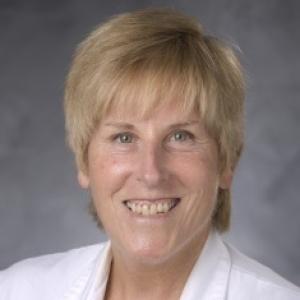
Professor of Medicine
Affiliate of the Duke Regeneration Center
Member of the Duke Cancer Institute
Campus Address
905 S. LaSalle Street, GSRB-1
DUMC 3256
Durham, NC 27710
Phone
919-684-6274
Education
Fellow in Gastroenterology, Johns Hopkins University, 1981-1984
Medical Resident, Johns Hopkins University, 1978-1981
MD, Georgetown University, 1978
Overview
The scope of the problem
The number of people who are known to have cirrhosis or liver cancer in the US has increased dramatically in the last 25 years. Many people who have chronic viral hepatitis or obesity/diabetes-related liver disease do not realize that they have these conditions. Because of this, they have not yet been diagnosed and are not receiving the appropriate treatment.
Why research livers?
It became apparent that there weren’t good treatments for common chronic liver injuries. Tests were not available either to identify those patients that are asymptomatic but are still at the highest risk for developing liver cancer or become cirrhotic. Currently, the only curative therapy for cirrhosis or liver cancer is surgical replacement of the damaged organ (i.e. liver transplantation). With this in mind there was motivation to clarify the basic mechanisms that regulate repair of the liver.
Research on cells has given the opportunity to discover and understand the fundamental mechanisms that we observe in patients. This helps to create new diagnostics and treatments that we are then able to test for efficacy. The efficacy results allow us to determine its relevance related to disease progression and allows us to more precisely pinpoint where is most important for liver repair.
Our lab has already identified liver gene expressions that differentiate patients with advanced NAFLD from those with milder versions. We have also discovered that many differences in liver gene expressions reflect epigenetic difference among individuals. These results combined may be used to modify epigenetic mechanisms to promote and optimize regeneration of the liver. Success in this area has broad implications for regenerative medicine that extend far beyond preventing cirrhosis, liver cancer, and death from NAFLD.
Solutions
To prevent cirrhosis and liver cancer, we must develop and apply effective treatments for liver disease, better understand how the liver normally repairs itself, learn what goes wrong with these normal repair processes when disease occurs, and use this knowledge to identify new ways to help the individuals with already-damaged livers and help regenerate new, healthy tissue.
Why Duke?
Duke GI Division faculty are already recognized as master liver clinicians and thought leader in liver research. We have the largest and most-well characterized human liver biobank in the world, and productive collaborations with local pathologists and genomics experts that are effectively exploiting this resource. Improved understanding of the processes that causes cirrhosis and liver cancer, coupled with our unique capabilities, will reduce death from liver disease by improving prevention, diagnosis and treatment.
Dr. Diehl’s research has resulted in a number of important findings. She has found that the activation of the SHH signaling pathway has shown promotion of disease progression. She has also been conducting clinical trials with patients who have chronic liver disease which has led to significant contributions. For example, while conducting the PIVENS trial Dr. Diehl’s team discovered that NASH in patients correlated with reduced activation of the SHH signaling pathway.
Dr. Diehl and her research has the potential to make a difference in patients suffering with liver disease. If this damage can be undone, liver diseases will no longer be viewed as terminal and as a death sentence.
Duke Liver Center Projects
Genomics NAFLD program Collaboration
Project: Analysis of liver transcriptome and liver methlyome in asymptomatic patients with either mild or NAFLD or advanced NAFLD.
Objectives:
- Identify differences in liver gene expression that differentiate groups of obese patients who have opposite risks for cirrhosis and apply this knowledge to guide development of non-invasive biomarkers.
- Determine to what extent (if any) epigenetic mechanisms contribute to the difference in liver gene exprewesion and use this knowledge to suggest potentially modifiable risk factors for NAFLD cirrhosis
Basic Science Apoptosis Researcher-NAFLD Translational Researcher Collaboration
Project: Determine potential clinical implication of Dr. Sally Kornbluth’s fundamental discovery that fatty acid-induced apoptosis is caspase-2 dependent in cultured HepG2 cells.
Objectives:
- Determine if caspase-2 deletion protects from cirrhosis caused by diet-induced nonalcoholic steatohepatitis (NASH), the progressive form of obesity-related liver damage.
- Localize caspase-2 in the livers of NASH patients and evaluate its relationship to severity of NASH injury and scarring.
France-US Intestinal Microbiome Collaboration
Project Hypothesis: Intestinal microbiome variation will influence severity of NAFLD damage and this effect will be modulated by host factors (age, gender, diet) and “corrected” by treating susceptible hosts with appropriate oral antibiotics.
Objectives:
- Characterize variation in the intestinal microbiome of human subjects with varying severities of NAFLD-related injury and fibrosis
- Define human host-microbiome interactions that predict differences in liver damage
- Test cause-effect relationship via studies in cell culture models
NAFLD Basic Research Accomplishments
- Identified role of innate immune system (NKT cells) in pathogenesis of NASH fibrosis
- Discovered NASH pathogenesis is regulated by reactivated developmental signaling pathways
- Discovered significance of Hedgehog signaling in regulating fate of hepatic stellate cells
- Identified novel role for caspase 2 in regulating systemic outcomes of lipotoxicity, including browning of white adipose, pancreatic beta cell hyperplasia, and NAFLD